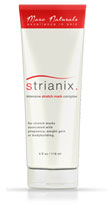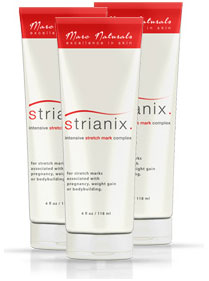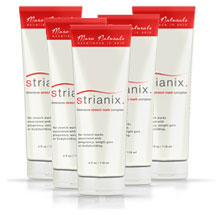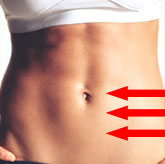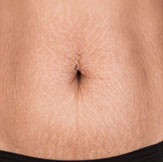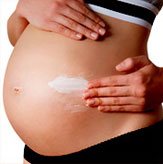Understanding Stretch Marks
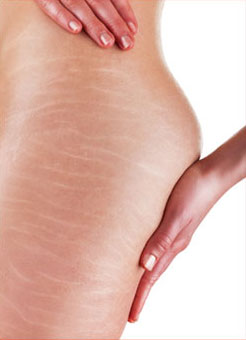
Typical stretch marks on the thigh
Appreciating the science of stretch marks led us to formulate the most effective and fast-acting product on the market today.
Dermatologists refer to stretch marks as striae or singularly as stria. Stretch marks are a form of scarring of the skin usually with an off-color (commonly white or pink), stirated (or striped) appearance. They are caused by a tearing within the middle layer of the skin called the dermis – which is located directly below the epidermis. The dermis is responsible for the skin’s firmness and shape.
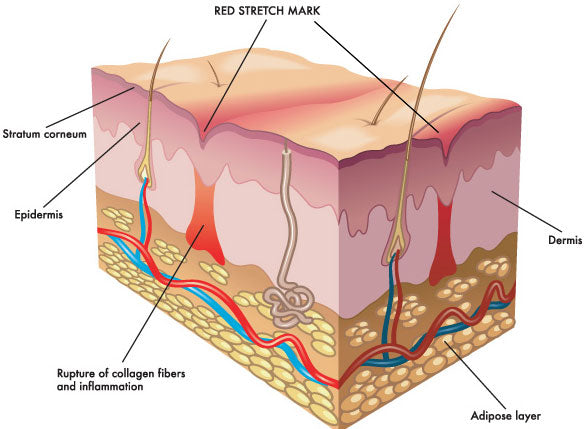
Who Gets Stretch Marks?
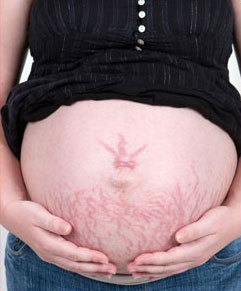
Unfortunately, pregnancy often causes stretch marks.
Both men and women can suffer from stretch marks. An individual’s likelihood of forming stretch marks is influenced by both their genetics and the physical changes they undergo. Stretch marks usually occur when there is rapid expansion of the skin– such as during pregnancy, or with body building or other rapid weight changes. The occurrence of stretch marks is also influenced by hormonal changes associated with puberty, pregnancy, bodybuilding, hormone replacement therapy, etc. Stretch marks formed during pregnancy are usually on the belly, but also commonly occur on the breasts, thighs, hips, lower back and buttocks. Stretch marks usually appear first as reddish or purplish lines, gradually fading to a lighter range. The affected areas are soft to the touch and appear shallow or empty. They are most likely to appear in places where larger amounts of fat are stored, such as the abdomen, upper arms, underarms, breasts, thighs, hips, and buttocks. They pose no health risk but can be quite unsightly and embarrassing.
Why We Get Them
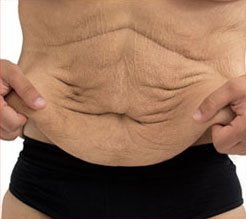
Male stretch marks after rapid weight loss.
Some studies show that low maternal age pregnancies, high body mass index, rapid weight gain over 33 pounds and higher neonatal birth weight cause most cases of stretch marks, although many people form stretch marks without these causes. Teenagers are at the highest risk of developing stretch marks, usually during puberty. There are hormones in our bodies called glucocorticoid hormones; high volumes create stretch marks by preventing the fibroblasts in our skin from forming enough collagen and elastin fibers to keep rapidly growing skin taut. This creates a lack of supportive material in the skin, and leads to dermal tearing and stretch marks. 50% to 90% of pregnancies result in some sort of stretch marks, and this is partly due to the normal hormonal changes during pregnancy and partly due to the over-stretching of skin fibers.
Stretch Marks Prevention

Keep the beautiful skin you were born with.
Skin that is healthy and full of collagen and supportive elastin fibers is most resistant to stretch marks. Topical creams that supply moisture and other ingredients that support collagen and elastin production will undoubtedly help prevent the severity of stretch marks and diminish any that do occur. Other important steps in dealing with stretch marks include a healthy diet, plenty of water and exercise and keeping weight gain under control. Of course weight gain during pregnancy is expected and wanted, so helping to prepare your skin in vulnerable areas, as well as remedial action after pregnancy, is recommended.
Treatments for Stretch Marks
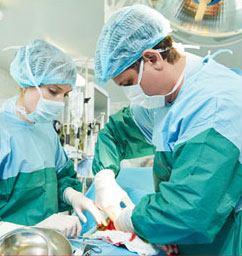
Surgery always carries some risk.
Various treatments exist to improve the appearance of stretch marks once they occur, but many are dangerous, expensive, painful and quite intrusive. These treatments include laser therapy, dermabrasion, and prescription retinoids. In fact the FDA has categorized one topical treatment, Tretinoin, which is a prescription retinoid, as a known teratogen, meaning that it causes malformations in animal fetuses.
Surgical procedures, such as the tummy tuck, removes the skin below the navel where stretch marks frequently occur. Dermabrasion actually grinds off layers of skin in a painful procedure that relies on your body’s healing capabilities to build new healthy skin. Fractional laser resurfacing uses scattered pulses of light to zap the stretch marks over the course of several treatments to create microscopic wounds which the body then heals thereby producing new collagen.
Our Solution

The best way to prevent and treat stretch marks is to incorporate proven, natural ingredients that have been used for centuries, and which work with your skin to encourage collagen and elastin production, and help your body to heal itself. No harsh prescription drugs or painful surgical techniques are needed. Strianix™ is safer and less expensive than other “medical” options and is proven in clinical trials to be effective when used just twice a day.
